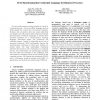Free Online Productivity Tools
i2Speak
i2Symbol
i2OCR
iTex2Img
iWeb2Print
iWeb2Shot
i2Type
iPdf2Split
iPdf2Merge
i2Bopomofo
i2Arabic
i2Style
i2Image
i2PDF
iLatex2Rtf
Sci2ools
120
click to vote
WECWIS
2006
IEEE
2006
IEEE
DAG Synchronization Constraint Language for Business Processes
Correct synchronization among activities is critical in a business process. Current workflow languages such as BPEL specify the control flow of processes explicitly. However, their procedural style may cause inflexibility and tangled code. We propose DSCL (Dag-acyclic-graph Synchronization Constraint Language) to achieve three desirable properties for a synchronization modeling language: declarative syntax, fine granularity and validation support. Instead of composing service out of structured constructs, DSCL declaratively describe the synchronization constraints in three basic relations on activity states. The state relationships collectively determine the execution order of activities in a composite process. The relationships are automatically translated into Petri Nets and simulated in the CPN/Tools, from which several correctness criteria can be validated for the composite process. We illustrate the advantages of DSCL
Business | Synchronization Constraint Language | Synchronization Constraints | Synchronization Modeling Language | WECWIS 2006 |
Related Content
| Added | 12 Jun 2010 |
| Updated | 12 Jun 2010 |
| Type | Conference |
| Year | 2006 |
| Where | WECWIS |
| Authors | Qinyi Wu, Akhil Sahai |
Comments (0)

